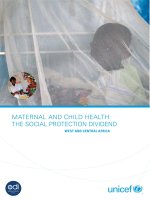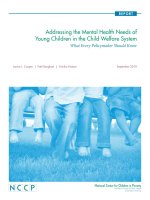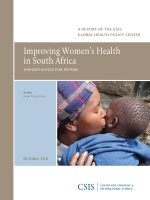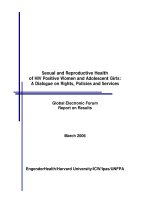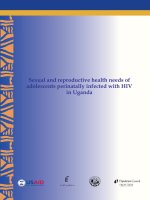Tài liệu Pulmonary tuberculosis among health care workers at two designated DOTS Centers in urban city of Ibadan, Nigeria docx
Bạn đang xem bản rút gọn của tài liệu. Xem và tải ngay bản đầy đủ của tài liệu tại đây (313.87 KB, 5 trang )
The risk of transmitting Mycobacterium
tuberculosis, the causative agent of tuberculosis (TB)
from infected patients to health care workers (HCWs)
has been recognized for many years
1
. The risk depends
on the settings, occupation, patient population and
effectiveness of the TB control measures
2
. The World
Health Organization (WHO) has proposed practical
Pulmonary tuberculosis among health care workers at two designated
DOTS Centers in urban city of Ibadan, Nigeria
A.O. Kehinde, A. Baba, R.A. Bakare, O.M. Ige
*
, C.F. Gbadeyanka
**
& O.E. Adebiyi
Departments of Medical Microbiology & Parasitology &
*
Medicine, College of Medicine, University College
Hospital &
**
Government Chest Hospital, Ibadan, Nigeria
Received September 18, 2009
Background & objectives: Tuberculosis (TB) infection control interventions are not routinely implemented
in many Sub-Saharan African countries including Nigeria. This study was carried out to ascertain the
magnitude of occupationally-acquired pulmonary TB (PTB) among health care workers (HCWs) at two
designated DOTS centers in Ibadan, Nigeria.
Methods: One year descriptive study (January-December 2008) was carried out at the University College
Hospital and Jericho Chest Hospital, both located in Ibadan, Nigeria. A pre-tested questionnaire was
used to obtain socio-demographic data and other relevant information from the subjects. Three sputum
samples were collected from each subject. This was processed using Zeihl-Neelsen (Z-N) stains. One of
the sputum was cultured on modied Ogawa egg medium incubated at 37
o
C for six weeks. Mycobacterium
tuberculosis was conrmed by repeat Z-N staining and biochemical tests.
Results: A total of 271 subjects, 117 (43.2%) males and 154 (56.8%) females were studied. Nine (3.3%)
had their sputum positive for acid fast bacilli (AFB) while six (2.2%) were positive for culture. The
culture contamination rate was 1.8 per cent. Signicantly, all the six culture positive samples were from
males while none was obtained from their female counterparts. About half of the AFB positive samples
were from subjects who have spent ve years in their working units. Eight AFB positive cases were from
21-50 yr age group while students accounted for seven AFB positive cases.
Interpretation & conclusions: The study shows that occupationally-acquired PTB is real in Ibadan.
Further studies are needed to ascertain and address the magnitude of the problem.
Key words Health care workers - infection control - Nigeria - TB
and low cost interventions to reduce nosocomial
transmissions of TB in resourced constrained settings
3
.
These recommendations emphasize prompt diagnosis
and rapid treatment of cases rather than use of expensive
technologies like isolation rooms and respirators
3
.
However, despite the widespread implementation of
the Directly Observed Therapy Short Course (DOTS)
Indian J Med Res 133, June 2011, pp 613-617
613
614 INDIAN J MED RES, JUNE 2011
strategy, which is internationally recommended,
compliance with these simple guidelines is generally
poor in low-income countries which harbour high
burden of the disease
4
.
In Nigeria and in other high burden countries, the
primary focus of the National TB Control Programmes
(NTCP) is scaling-up of DOTS services while
nosocomial transmission of the disease is relegated
to the background
5
. As a result, TB infection control
interventions are not routinely implemented, in
contrast to what happens in high income countries with
low prevalence of TB where infection control policy is
routinely observed
5
.
Despite the high prevalence of TB in Nigeria
with its antecedent high morbidity and mortality,
little is known about occupationally-acquired TB in
the country. This study was, therefore, carried out to
determine the magnitude of occupationally-acquired
TB among health care workers (HCWs) at two DOTS
centers in Ibadan, Nigeria.
Material & Methods
Study design & area: This is a descriptive
epidemiological study in which HCWs such as doctors,
nurses, radiographers, laboratory scientists, laboratory
assistants, ward maids and students who were involved
in the management of TB patients were screened for
pulmonary TB (PTB).
The study was carried out at the two designated
DOTS centers, the University College Hospital (UCH),
Ibadan, a tertiary health care facility and Jericho Chest
Hospital (JCH) which serves as a referral secondary
health care center.
The two health institutions are located within Ibadan
metropolis. Ibadan is the capital city of Oyo State of
Nigeria with a population of about ve million
6
. The TB
laboratory of the Department of Medical Microbiology
and Parasitology is located at the UCH. The laboratory
is a designated facility for isolation of M. tuberculosis
in the Southwestern part of the country. It is supported
by Damien Foundation, Belgium through the NTCP of
the Federal Ministry of Health, Abuja.
Study population: Of the 385 HCWs working in 2
centre, (UCH and JCH DOTS), 271 (70.4%) subjects
gave their consent and participated in the study from
January to December 2008. The study protocol was
approved by the University of Ibadan and UCH joint
ethical committee. Verbal and written informed consent
was obtained from the subjects before enrollment into
the study. Those who refused to give written consent
were excluded.
A pre-tested questionnaire was used by a trained
counselor to obtain information on demographic
characteristics, social and medical history from the
subjects. Other important information about PTB such
as previous BCG vaccination, contact with an index
case and exposure to tuberculin skin test were also
obtained.
Laboratory investigations: Three early morning sputum
were collected from each consenting asymptomatic
subject. The samples were transported to TB laboratory
of the department of Medical Microbiology and
Parasitology, UCH, for immediate processing. Each
sample was smeared, air-dried, xed and stained with
Z-N reagents. The staining procedure was controlled
by using known AFB slide and slide stained with egg
albumin as positive and negative controls respectively.
The results was read according to the grading
system of the International Union Against TB and Lung
Diseases as - , +, ++, +++
7
. Thereafter, the sputum was
decontaminated using 4 per cent NaOH. The resulting
solution was mixed using vortex mixer. About one ml
from the mixture was inoculated onto prepared modied
Ogawa egg medium as previously demonstrated
8
and
incubated at 37
o
C for six weeks. M. tuberculosis strain
H37Rv and sterile Ogawa medium were used as positive
and negative controls respectively. Contamination on
Ogawa medium was determined by looking for growth
before two weeks of incubation and by carrying out
Z-N reaction and standard biochemical tests
9
. Subjects
from whom AFB positive samples were obtained and
or those with culture positive samples were referred to
the chest physician for further re-evaluation.
Molecular studies and drug susceptibility testing of
the isolates were not done due to inadequate facilities.
Statistical analysis: All data were coded and analyzed
using statistical software SPSS version 10.0 (SPSS
Inc, Chicago, IL, USA). Frequency tables were used
to describe demographic characteristics and laboratory
variables while Chi square test was used to measure
the association between categorical variables where
necessary.
Results
Consent was sought from 385 HCWs who were
working at the two centers, of whom 271 subjects
(70.4%) gave consent and participated in the study
giving a male: female ratio of 0.75 to 1.00 respectively.
Only four (1.5%) were over 60 yr while the majority, 151
(55.7%) were aged 21-40 yr. Of the 271 subjects, 102
(37.6%) were professionals while non-professionals
accounted for 169 (62.4%) (Table I).
The majority, 160 (59.0%) of the subjects had been
working in their units for more than two years while 64
(23.6%) had not spent up to one year in their various
units. Most 254 (93.7%) reported negative history of
chronic cough while a higher percentage 257 (94.8%)
denied any history of smoking. In relation to alcohol
consumption, 44 (16.2%) gave history of alcohol intake,
the majority 208 (76.8%) gave a negative history while
19 (7.0%) did not give any denite answer.
Eleven (4.1%) subjects agreed to recently have
contact with patients with chronic cough, 178 (65.7%)
gave negative response while 82 (30.3%) did not
answer the question.
Concerning previous history of tuberculin skin test
(bubble under the skin), 36.9 per cent of the subjects
had a positive tuberculin skin test in the past while 63.1
per cent of them had a negative result. The majority
of the subjects 164 (60.5%) did not receive Bacille-
Calmette Guerin (BCG) vaccination, only 88 (32.8%)
had received BCG vaccination while 19 (6.6%) did
not remember. In terms of previous treatment for TB
infection, 222 (81.9%) gave negative answer, while 49
(18.1%) agreed to have had previous treatment for TB
before they started working in the hospital.
Nine (3.3%) of the 271 subjects had their sputum
positive for AFB on microscopy while 262 (96.7%)
were negative. Six (2.2%) samples were positive for
culture, 260 (95.9%) were negative while ve (1.8%)
were contaminants. The majority, 262 (96.7%) were
both AFB and culture negative while only six (2.2%)
were both AFB and culture positive (Table II). Eight
of the nine AFB positive samples were obtained from
subjects aged 21-50 yr while only one was from
adolescent age group. The association between AFB
positivity and age of the subjects was not statistically
signicant.
In terms of distribution of AFB positive samples
by sex of the subjects, six (5.1%) were obtained
from males (n=117) while females accounted for
three (2.0%) cases. All the six AFB positive samples
were positive for culture. All the six culture positive
samples were from males while none was obtained
from their female counterparts (Table III). More than
three quarters (77.7%) of the positive AFB samples
were from students while none was obtained from the
professionals (physicians, nurses, laboratory scientists
and radiographers).
Four of the nine AFB positive samples were from
subjects who had been working in their units for the
past ve years, three spent less than one year at their
duty post while those with 1-2 and 2-3 yr experience,
each had one AFB sample positivity.
Discussion
The risk of transmission of M. tuberculosis from
PTB patients to HCWs is a neglected problem in
Table I. Demographic characteristics of the subjects by sex
Variable Sex Total
Male Female
Age (yr)
<20 05 (29.4) 12 (70.6) 17 (100.0)
21-40 68 (45.0) 83 (55.0) 151 (100.0)
41-60 41 (41.4) 58 (58.6) 99 (100.0)
>60 03 (75.0) 01 (25.0) 04 (100.0)
Total 117 (43.2) 154 (56.8) 271 (100.0)
Profession
Physician 15 (60.0) 10 (40.0) 25 (100.0)
Nurse 08 (17.4) 38 (82.6) 46 (100.0)
Lab. scientist 19 (65.5) 10 (34.5) 29 (100.0)
Radiographer 01 (50.0) 01 (50.0) 02 (100.0)
Lab. assistant 10 (52.6) 09 (47.4) 19 (100.0)
Hospital maid 04 (15.4) 22 (84.6) 26 (100.0)
Lab students 60 (48.4) 64 (51.6) 124 (100.0)
Total 117 (43.2) 154 (56.8) 271 (100.0)
Figures in parentheses are percentages
Table II. AFB and Culture results of the HCWs at the two DOTS
centers
Test Result
AFB only
Positive
Negative
Total
09 (3.3)
262 (96.7)
271 (100.0)
Culture only
Positive
Negative
Contaminant
Total
06 (2.2)
260 (96.0)
05 (1.8)
271 (100.0)
Combined AFB and Culture
AFB negative culture positive
AFB positive culture negative
AFB negative culture negative
AFB positive culture positive
Total
0 (0.0)
03 (1.1)
262 (96.7)
06 (2.2)
271 (100.0)
Figures in parentheses are percentages
KEHINDE et al: TB AMONG HEALTH-CARE WORKERS 615
low-income countries with high burden of TB
10
. The
infection rates of 3.3 per cent by microscopy and
2.2 per cent by culture obtained from this study is
similar to 2.1 and 3.1 per cent obtained in Malawian
and South African studies respectively
11,12
but higher
than 1.5 per cent reported by Salami and Oluboyo in
their retrospective review of 2,173 cases in Ilorin in
2008
13
. This may be due to the fact that previous study
did not include secondary and primary health care
centers where infection control policy might likely
be compromised. The diagnostic yield of microscopy
(3.3%) was higher than the 2.2 per cent obtained for
culture. This may be as a result of high rate of false
positivity which is often associated with microscopy as
it does not distinguish pathogenic mycobacteria from
the commensals. Furthermore, smear false positivity is
often associated with poor quality of sputum samples,
deciencies in preparation of stains, staining procedure
or examination of stained slides
14
. The fact that all the six
culture positive isolates were also AFB positive while the
remaining three AFB positive samples were negative on
culture indicates that performance of smear microscopy
as a diagnostic tool in this study was reliable.
The mycobacterial culture contamination rate of
1.8 per cent obtained in this study was lower than that
of 5.1 per cent obtained in the same center years back
15
.
This may be attributed to the fact that previous study
was carried out in children. Previous report has shown
that collection and processing of specimen for TB
diagnosis in children is often problematic and prone
to contamination especially in endemic settings with
limited human and infrastructural facilities
16
. Also,
recent trainings in Good Laboratory Practice by the
laboratory scientists may account for their subsequent
improvement in processing clinical specimens.
Almost all (eight of the nine) positive AFB
samples were from the age bracket 20-60 yr. This is
worrisome as this age group constitutes the economic
vibrant group of the population. TB infection affecting
the vibrant work force may further aggravate shortage
of HCWs which may cripple delivery of health care
systems in the country.
Majority of the infected samples were from subjects
who had spent more than two years in their units.
Longer exposure of the HCW to an infectious PTB
patient increases the risk of contacting occupationally-
acquired TB
10,17
.
Small samples and study area covering only 2
DOTS centers are some of the study limitations.
Other limitations include exclusion of testing for
latent TB infection (LTBI). This was as a result
of shortcomings associated with use of the only
available diagnostic tool- Tuberculin (Mantoux) skin
test (TST). These include invasive nature of the test,
the need for the patient to come back for follow up
TST reading, cross-reactivity with environmental
mycobacteria and previous BCG vaccination. There
is a need to assess the magnitude of LTBI among
HCWs using more reliable serological assays such as
the T-cell based assays which measure the interferon
–gamma released after stimulation by M. tuberculosis.
Examples of such assays include QuatiFeron TB
Gold by Cellestis InC, USA and T- SPOT
TM
. TB by
Oxford Immunotech, England
18
.
Chest radiograph
and HIV serological status of the subjects were
also not done. This was primarily due to nancial
constraints. Assessment of chest radiograph may be
useful especially in situations of clinically conrmed
cases but with confusing laboratory results. Further,
inclusion of non-responders which constitutes 30 per
cent of the total HCWs at the two study centers could
probably alter the disease pattern.
The primary concerns of the NTCP in many
resourced-poor countries with high burden of TB
are failure to meet case detection and drug treatment
Table III. Laboratory results by sex, profession and duration of stay
Laboratory results
Variable AFB Culture
Positive Negative Positive Negative
Sex
Male (n=117)
Female (n= 154)
Total (n= 271)
06 (5.1)
03 (2.0)
09 (3.3)
111 (94.9)
151 (98.0)
262 (96.7)
06 (5.1)
0 (0.0)
06 (2.2)
111 (94.9)
154 (100.0)
265 (97.8)
Profession
Physician (n=25)
Nurse (n=46)
Lab scientist (n=29)
Radiographer (n=02)
Lab assistant (n= 19)
Hospital maid (n=25)
Students (n=124)
Total (n=271)
Duration of stay (yr)
< 1 (n= 64)
1-2 (n = 47)
2-3 (n = 68)
>3 ( n = 92)
Total (n = 271)
0 (0.0)
0 (0.0)
0 (0.0)
0 (0.0)
01 (5.3)
01 (4.0)
07 (5.7)
09 (3.3)
03 (4.7)
01 (2.1)
01 (1.5)
04 (4.4)
09 (3.3)
25 (100.0)
46 (100.0)
29 (100.0)
02 (100.0)
18 (94.7)
24 (96.0)
117 (94.3)
262 (96.7)
61 (95.3)
46 (97.9)
67 ( 98.5)
88 (95.6)
262 (96.7)
0 (0.0)
0 (0.0)
0 (0.0)
0 (0.0)
01 (5.3)
01 (4.0)
04 (3.2)
06 (2.2)
01 ( 1.6)
0.0 (0)
01 ( 1.5)
04 (4.4)
06 (2.2)
25 (100.0)
46 (100.0)
29 (100.0)
02 (100.0)
18 (94.7)
24 (96.0)
120 (96.8)
265 (97.8)
64 (98.4)
47 (100.0)
67 ( 98.5)
88 ( 95.6)
265 (97.8)
Figures in parentheses are percentages
616 INDIAN J MED RES, JUNE 2011
targets
19
. Nevertheless, NTCP in these countries
should nd ways of incorporating TB infection control
interventions into their DOTS programme in other to
reduce exposure of their valuable HCWs from getting
occupationally-acquired TB.
Acknowledgment
This work was partly supported by the University of Ibadan,
senate research grant No: SGR/COM/2006/41A awarded to the
rst author (AOK). Authors thank Mrs Olufunke Oluwatoba of the
Department of Medical Microbiology and Parasitology, College of
Medicine, University of Ibadan, Nigeria, for her assistance in data
analysis.
References
Sepkowitz KA. Tuberculosis and the health care worker: a 1.
historical perspective. Ann Intern Med 1994; 120 : 71-9.
Blumberg HM. Tuberculosis infection control in health care 2.
settings. In: Lautenbach E, Woeltje K, editors. Practical
handbook for health care epidemiologists, New Jersey; Slack
Incorporated; 2004. p. 259-73.
World Health Organization. Guidelines for the prevention 3.
of tuberculosis in health care facilities in resource-limited
settings. WHO, Geneva; 1999. WHO/TB/99.269. Available
from: www.who.int/tb/publications/whotb99269/en/index/
html.
Jones-Lopez EC, Ellner JJ. Tuberculosis infection among 4.
HCWs. Int J Tuberc Lung Dis 2005; 9 : 591.
Blumberg HM, Watkins DL, Berschling JD, Antle A, Moore 5.
P, White N. Preventing the nosocomial transmission of
tuberculosis. Ann Intern Med 1995; 122 : 658-63.
6. Federal Republic of Nigeria Ofcial Gazette. Legal notice
of publication of 2006 census nal results. Abuja, Nigeria:
Federal Government of Nigeria; 2009, vol. 2 (96) p. 38-9.
Enarson DA7. . Laboratory diagnosis of pulmonary tuberculosis.
In: Enarson DA, editor. Management of tuberculosis. a guide
for low income countries, 5
th
ed. Paris: International Union
Against Tuberculosis and Lung Diseases; 2000. p. 1-50.
Saito H, Hiramine S, Watanabe T. Isolation of tubercle bacteria 8.
using Ogawa egg medium modied by addition of Tween 80.
Zentralbl Bakteriol (Orig A) 1978; 242 : 132-6.
Barrow GI, Feltham RKA. Identication of medical bacteria. 9.
In: Cowan ST, Steel KJ, editors. Manual for the identication
of medical bacteria. Cambridge: Cambridge University Press;
1995. p. 91-3.
Joshi R, Reingold AL, Menzies D, Pai M. Tuberculosis among 10.
health-care workers in low- and middle-income countries: a
systematic review. PLoS Med 2006; 3 : e494.
Claessens NJ, Gausi FF, Meijnen S, Weismuller MM, 11.
Salaniponi FM, Harries AD. High frequency of tuberculosis
in households of index TB patients. Int J Tuberc Lung Dis
2002; 6 : 266-9.
Gilpin TP, Hammond M. Active case-nding-for the whole 12.
community or for tuberculosis contacts only? S Afr Med J
1987; 72 : 260-2.
Salami AK, Oluboyo PO. Health care workers and risk of 13.
hospital-related tuberculosis. Niger J Clin Pract 2008; 11 :
32-6.
World Health Organization. 14. Toman’s tuberculosis case
detection, treatment and monitoring: questions and answers.
2
nd
ed. Geneva: World Health Organization; 2004. WHO/
HTM/TB/2004.334.
Oludiran KA, Eziuka OR, Mayowa IO, Ajani BR, Kikelomo 15.
O. Bacteriology of childhood tuberculosis in Ibadan, Nigeria:
a ve-year review. Trop Med Health 2008; 36 : 127-30.
World Health Organization. 16. Guidance for national tuberculosis
programmes on the management of tuberculosis in children.
Geneva: World Health Organization; 2006. WHO/HTM/
TB/2006.371.
Menzies D, Joshi R, Pai M. Risk of tuberculosis infection 17.
and disease associated with work in health care settings. Int J
Tuberc Lung Dis 2007; 11 : 593-605.
Meier T, Eulenbruch HP, Wrighton-Smith P, Enders G, 18.
Regnath T. Sensitivity of a new commercial enzyme-linked
immunospot assay (T SPOT-TB) for diagnosis of tuberculosis
in clinical practice. Eur J Clin Microbiol Infect Dis 2005, 24
: 529-36.
Morrison J, Pai M, Hopewell PC. Tuberculosis and latent 19.
tuberculosis infection in close contacts of people with
pulmonary tuberculosis in low-income and middle-income
countries: a systematic review and meta-analysis. Lancet
Infect Dis 2008; 8 : 359-68.
Reprint requests: Dr A.O. Kehinde, TB Unit, Department of Medical Microbiology & Parasitology, College of Medicine,
University College Hospital, University of Ibadan, Nigeria
e-mail:
KEHINDE et al: TB AMONG HEALTH-CARE WORKERS 617

